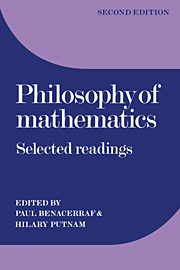Book contents
- Frontmatter
- Contents
- Preface to the second edition
- Introduction
- Part I The foundations of mathematics
- Part II The existence of mathematical objects
- Part III Mathematical truth
- Part IV The concept of set
- Russell's mathematical logic
- What is Cantor's continuum problem?
- The iterative concept of set
- What is the iterative conception of set?
- The concept of set
- Bibliography
The concept of set
Published online by Cambridge University Press: 05 June 2012
- Frontmatter
- Contents
- Preface to the second edition
- Introduction
- Part I The foundations of mathematics
- Part II The existence of mathematical objects
- Part III Mathematical truth
- Part IV The concept of set
- Russell's mathematical logic
- What is Cantor's continuum problem?
- The iterative concept of set
- What is the iterative conception of set?
- The concept of set
- Bibliography
Summary
The (maximum) iterative concept
A set is a collection of previously given objects; the set is determined when it is determined for every given object x whether or not x belongs to it. The objects which belong to the set are its members, and the set is a single object formed by collecting the members together. The members may be objects of any sort: plants, animals, photons, numbers, functions, sets, etc.
According to the iterative concept, a set is something obtainable from some basic objects (such as the empty set, or the integers, or individuals, or some other well-defined urelements) by iterated applications of the rich operation ‘set of’ which permits the collecting together of any multitude of ‘given’ objects (in particular, sets) or any part thereof into a set. This process includes transfinite iterations. For example, the multitude of sets obtained by finite iteration is considered to be itself a set.
We understand this concept of set sufficiently well to see, after some deliberation, and in some cases even a great deal of deliberation, that the ordinary axioms of set theory are true for (or with respect to) this concept, and to be able to extend these axioms by proposing additional axioms and recognizing some of them to be true for (or with respect to) it.
The iterative concept involves at least four difficult ideas: the idea of ‘given’, the idea of collecting together, the idea of ‘part’ or subset, and the idea of iteration.
- Type
- Chapter
- Information
- Philosophy of MathematicsSelected Readings, pp. 530 - 570Publisher: Cambridge University PressPrint publication year: 1984
- 8
- Cited by

